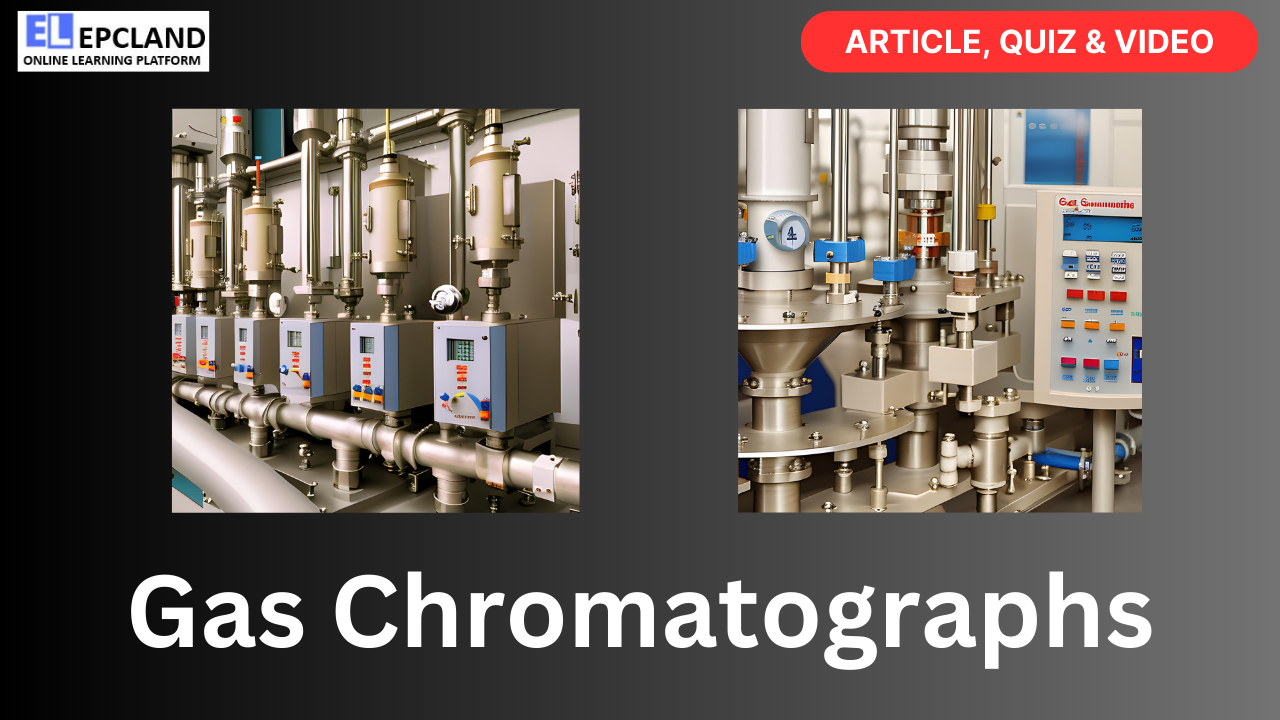In the vast and intricate world of the Oil & Gas Industry, accurate analysis of hydrocarbon composition is pivotal for efficient production and quality control. Gas chromatography, a powerful analytical technique, plays a central role in unveiling the molecular secrets of hydrocarbons, making it a critical tool for various oil and gas projects. This article delves deep into the realm of gas chromatographs, exploring their principles, applications, and indispensable role in the industry.
Table of Contents
Do not miss the Complete Course on Piping Engineering
By EPCLand
Understanding Gas Chromatography
The Essence of Gas Chromatography
Gas chromatography is a highly versatile analytical technique used to separate, identify, and quantify the individual components of complex mixtures, particularly gases and volatile liquids. It is a fundamental tool in the Oil & Gas Industry, as it allows for precise analysis of hydrocarbon samples from various stages of the production process.
How Gas Chromatographs Work
Gas chromatographs (GCs) operate on the principle of differential partitioning. Here’s a simplified overview of how they work:
- Sample Injection: A small amount of the sample (liquid or gas) is introduced into the chromatograph.
- Vaporization: If the sample is a liquid, it is vaporized to convert it into a gas. This is achieved by passing it through a heated injection port.
- Column Separation: The sample is then injected into a chromatographic column, which contains a stationary phase (typically a coated tube) and a carrier gas (often helium or nitrogen). The sample molecules partition between the stationary phase and the carrier gas as they move through the column.
- Separation: Different components in the sample interact differently with the stationary phase, causing them to travel at different rates through the column. This separation process results in the individual components exiting the column at distinct times.
- Detection: As the components exit the column, they pass through a detector, such as a flame ionization detector (FID) or a mass spectrometer (MS). The detector records the presence and quantity of each component.
- Data Analysis: The data collected from the detector are then analyzed to determine the composition of the sample.
Working Principle of Gas Chromatography
The fundamental principle underlying gas chromatography is the differential partitioning of sample components between a stationary phase and a mobile phase (the carrier gas). Key aspects of the working principle include:
- Partition Coefficient: Each component in the sample has a specific affinity for the stationary phase. Some components are more attracted to the stationary phase, causing them to spend more time interacting with it. This results in differential migration rates through the column.
- Retention Time: The time it takes for a component to travel through the column and reach the detector is called its retention time. Components with longer retention times spend more time interacting with the stationary phase.
- Detection: The detector at the end of the column senses the components as they exit the column. Different detectors respond to different physical or chemical properties of the analytes, such as thermal conductivity, ionization, or mass-to-charge ratio.
- Data Analysis: The chromatogram, a graphical representation of detector signals over time, provides information about the components’ retention times and quantities. Analysis software processes the chromatogram to determine the composition of the sample.
Applications of Gas Chromatographs in Oil & Gas Projects
Hydrocarbon Exploration and Reservoir Analysis
In the exploration phase of oil and gas projects, gas chromatography plays a pivotal role in identifying and characterizing hydrocarbon reservoirs. It allows geologists and petrologists to analyze the composition of fluid samples from wells, helping them determine the presence of oil and gas, as well as estimate their quantities.
Well Logging and Formation Evaluation
Gas chromatographs are used in well logging tools to assess the composition of formation fluids encountered while drilling. This information is crucial for making real-time decisions about well completion and production strategies.
Refinery and Petrochemical Analysis
Refineries rely on gas chromatography to monitor and optimize the refining processes. It is used for:
- Feedstock Analysis: GC helps determine the composition of crude oil and feedstocks, enabling refineries to adjust processing parameters for optimal yields and product quality.
- Product Quality Control: It is used to ensure that the final products, such as gasoline and diesel, meet regulatory and quality specifications.
- Emissions Monitoring: GC is instrumental in monitoring and controlling emissions from refining processes to comply with environmental regulations.
Natural Gas Analysis
Gas chromatography is extensively used for the analysis of natural gas, which is primarily composed of methane but can contain other hydrocarbons and impurities. Key applications include:
- Gas Composition Analysis: GC precisely determines the composition of natural gas, including the percentages of methane, ethane, propane, butane, and other hydrocarbons.
- Determination of Impurities: It identifies and quantifies impurities like hydrogen sulfide (H2S) and carbon dioxide (CO2) that need to be removed from natural gas to meet pipeline specifications.
Environmental Monitoring and Compliance
Gas chromatography is a valuable tool for environmental monitoring in the Oil & Gas Industry. It is used to analyze air and water samples for pollutants and emissions, ensuring compliance with environmental regulations.
Research and Development
Innovations in oil and gas exploration and production often rely on the research and development efforts of engineers and scientists. Gas chromatography aids in the development of new processes and technologies, from enhanced oil recovery methods to the production of cleaner fuels.
Do not miss the Complete Course on Piping Engineering
By EPCLand
Types of Gas Chromatographs
Gas-Liquid Chromatography (GLC)
In GLC, the stationary phase is a liquid coated on a solid support. It is ideal for separating compounds with varying volatilities and is commonly used for analyzing liquid samples and relatively volatile gases.
Gas-Solid Chromatography (GSC)
GSC employs a solid stationary phase. This technique is suitable for separating gases or volatile compounds with different affinities for the solid phase.
Gas-Solid Adsorption Chromatography (GSAC)
GSAC is a specific type of GSC that uses a solid adsorbent as the stationary phase. It is particularly effective in analyzing trace components in gas mixtures.
Gas-Liquid-Solid Chromatography (GLSC)
GLSC combines the principles of both GLC and GSC, incorporating a liquid stationary phase and a solid adsorbent. This allows for versatile separations of complex mixtures.
High-Performance Liquid Chromatography (HPLC)
HPLC is a related technique that uses a liquid mobile phase under high pressure. While it is primarily used for non-volatile compounds, it finds applications in petrochemical analysis and is often employed alongside gas chromatography.
Advantages and Disadvantages of Gas Chromatography
Below is a table summarizing the advantages and disadvantages of gas chromatography:
| Advantages | Disadvantages |
|---|---|
| High Separation Efficiency | Limited to Volatile Compounds |
| Excellent Quantitative Precision | Sample Preparation Required |
| Wide Range of Applications | Limited Sensitivity for Trace Components |
| Quick Analysis Time | Complex Equipment Setup |
| Versatile Detection Options | Column Maintenance and Replacement Required |
| Precise Identification of Compounds | High Initial Cost |
| Low Sample Consumption | Skill-Intensive Operation |
| Minimal Sample Contamination | Incompatibility with Non-Volatile Compounds |
Do not miss the Complete Course on Piping Engineering
By EPCLand
Challenges and Future Trends
While gas chromatography is a powerful analytical technique, it does come with its set of challenges in the Oil & Gas Industry:
Sample Conditioning: Proper sample conditioning is crucial to ensure that the sample is in the correct state (vaporized or liquid) and free from contaminants before injection into the chromatograph.
Column Maintenance: The chromatographic column is a critical component that requires routine maintenance and replacement to maintain optimal performance.
Analytical Precision: Achieving high precision in quantifying trace components can be challenging and may require sophisticated calibration techniques.
Complex Sample Matrices: In some cases, the presence of complex matrices or co-eluting compounds can complicate the analysis and require advanced separation techniques.
Looking ahead, several trends are shaping the future of gas chromatography in the Oil & Gas Industry:
Miniaturization: Continued efforts in miniaturizing gas chromatographs will make them more accessible for field applications, enabling real-time analysis at well sites and refineries.
Environmental Concerns: Growing environmental awareness is driving the need for more comprehensive monitoring of emissions and pollutants, a task for which gas chromatography is well-suited.
Data Integration and AI: Integrating gas chromatographs with artificial intelligence (AI) and data analytics will allow for more intelligent data interpretation, trend analysis, and predictive maintenance.
Hyphenation Techniques: Combining gas chromatography with other analytical techniques, such as mass spectrometry and spectroscopy, will enable more comprehensive sample characterization.
Conclusion
Gas chromatographs are the unsung heroes of the Oil & Gas Industry, revealing the molecular secrets of hydrocarbons and providing the data necessary for informed decision-making. From exploring reservoirs to optimizing refining processes and ensuring environmental compliance, gas chromatography plays a pivotal role at every stage of oil and gas projects.
As technology continues to advance, gas chromatography is poised to become even more integral to the industry’s success. Its ability to provide precise and reliable data, coupled with ongoing innovations, positions it as an indispensable tool for the Oil & Gas Industry’s future challenges and endeavors.
In summary, gas chromatography is not merely a laboratory technique; it is an essential ally that helps the Oil & Gas Industry unlock the potential of hydrocarbons while maintaining quality, safety, and environmental responsibility.
FAQs
1. What is the primary role of gas chromatography in the Oil & Gas Industry?
- Gas chromatography is primarily used for analyzing the composition of hydrocarbons, such as natural gas and crude oil. It helps in identifying individual components, ensuring product quality, and meeting regulatory requirements.
2. What types of detectors are commonly used in gas chromatographs for oil and gas applications?
- Common detectors include Flame Ionization Detectors (FID) for hydrocarbon analysis, Thermal Conductivity Detectors (TCD) for non-destructive quantification, and Mass Spectrometers (MS) for precise compound identification.
3. How does gas chromatography contribute to environmental compliance in the industry?
- Gas chromatography helps monitor and control emissions from industrial processes in compliance with environmental regulations. It enables the detection and quantification of pollutants, ensuring that emissions are within permissible limits.
4. What are some key challenges associated with gas chromatography in the Oil & Gas Industry?
- Challenges include proper sample conditioning, maintenance of chromatographic columns, achieving high precision in trace component analysis, and dealing with complex sample matrices that may contain co-eluting compounds.
5. How is gas chromatography evolving to meet the industry’s changing needs?
- Gas chromatography is evolving through miniaturization for on-site analysis, integration with artificial intelligence (AI) for smarter data interpretation, and hyphenation with other analytical techniques for more comprehensive sample characterization. These advancements help address environmental concerns and improve efficiency in the industry.
Recommended courses (Published on EPCLand)
- Basics of Piping Engineering
- Piping Layout Engineering
- Piping Material Engineering
- Piping Stress Analysis
- Complete Course on Piping Engineering
- Material Requisitions
- Piping Material Specifications
- Valve Material Specifications
Don’t miss the published articles on following:
| Data Analysis and Technology with Link | Data Analysis and Technology with Link |
| Data Analytics | Industrial Control Networks |
| Machine Learning | The Power of Acoustic Sensors |
Do not miss the Complete Course on Piping Engineering
By EPCLand
Related Video
Attempt Quiz
Question 1:
What is the primary function of a gas chromatograph in oil & gas projects?
Explanation: A gas chromatograph is primarily used in oil & gas projects for analyzing the composition of gases, making option B the correct answer.
Question 2:
What is the principle behind gas chromatography?
Explanation: Gas chromatography operates on the principle of separating compounds based on their boiling points, so option C is correct.
Question 3:
What is the purpose of a detector in a gas chromatograph?
Explanation: The detector in a gas chromatograph is responsible for identifying and quantifying the separated compounds, making option C the correct answer.
Question 4:
What type of gases can be analyzed using a gas chromatograph in the oil & gas industry?
Explanation: Gas chromatographs in the oil & gas industry can analyze a wide range of hydrocarbons and other gases, so option C is correct.
Question 5:
What is the benefit of using a gas chromatograph in oil & gas projects?
Explanation: One of the benefits of using a gas chromatograph in oil & gas projects is improving product quality and process efficiency, making option D the correct answer.



